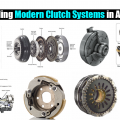
Ever wonder what secrets lie beneath the hood of a supercar? Uncover the hidden power of advanced engine materials, from heat-resistant ceramics to lightweight composites. This article dives deep into how they’re transforming engine performance, efficiency, and sustainability.
Engine Materials: From Iron to Innovation
🔩 A Look Back at Traditional Engine Materials
Engines were once built almost entirely out of cast iron and steel. These metals were chosen for their strength and durability, but they came with some drawbacks. Cast iron, for example, is very heavy, which adds unnecessary mass to a vehicle. It also doesn’t handle extreme heat or friction well in the long term. While strong, these metals are limited in how efficiently they can perform under modern performance demands.
⚙️ The Shift to Lightweight Alloys
As automotive technology advanced, so did the need for lighter and more efficient materials. Aluminum alloys became popular due to their reduced weight and decent thermal properties. This helped improve fuel economy and made vehicles more responsive. However, aluminum still lacks the high heat tolerance and wear resistance needed for the most demanding applications—like racing engines or turbocharged systems.
🚀 The Rise of Advanced Engine Materials
Enter the new age of engine innovation—ceramics, composites, and exotic alloys. These materials are specifically engineered to outperform metals in high-stress environments. They offer:
- Lower weight
- Higher heat resistance
- Longer lifespan
- Improved mechanical performance
These materials are not just science fiction—they are being used in modern engines today, especially in performance vehicles, motorsports, and even aerospace applications.
Unveiling the Power of Ceramics
🔥 What Are Ceramic Engine Materials?
In the automotive world, advanced ceramics are not fragile like household pottery. These are engineered materials, often made from silicon nitride, zirconia, or alumina, that can handle extreme temperatures, resist corrosion, and stay strong under pressure.
🧩 Ceramic Components in Engines
Ceramics are now used to manufacture parts that face the harshest conditions inside an engine:
- Pistons: Withstand explosive combustion heat and reduce friction.
- Valves: Maintain shape and function even at red-hot temperatures.
- Turbocharger Rotors: Spin at incredibly high speeds without warping.
These parts often face temperatures above 1000°C (1832°F). Ceramics remain stable and do not expand as much as metals, ensuring precision and reliability.
🛡️ Ceramic Coatings: A Thin Layer of Protection
Instead of replacing the whole part, manufacturers also apply thin ceramic coatings to existing engine components like:
- Cylinder heads
- Exhaust manifolds
- Combustion chamber walls
These coatings improve thermal insulation, allowing the engine to retain more heat where needed, and also reduce wear from friction. In performance engines, this means more efficient combustion, more power, and longer-lasting parts.
✅ Key Benefits of Ceramic Materials
- Extreme heat resistance: Ideal for turbocharged and high-performance engines.
- Friction reduction: Less energy is lost to heat, boosting performance.
- Improved durability: Fewer repairs and longer service intervals.
The Rise of Composite Materials
🧪 What Are Composites?
Composites are materials made by combining two or more different substances to create something stronger, lighter, and more versatile. The most common combinations include carbon fibers, glass fibers, and resins. In engines, these materials provide the strength of metal without the weight penalty.
🔧 Engine Components Using Composites
Automakers are increasingly using composites in critical engine parts:
- Crankshafts and connecting rods: These are normally heavy, but carbon fiber composites reduce mass while maintaining strength.
- Cylinder heads and cam covers: Composites help lower weight and improve heat insulation.
- Timing belts and covers: Made from reinforced polymers that are both lightweight and resistant to oil and heat.
⚖️ Advantages Over Traditional Metals
- Lightweight: Composites can be up to 60% lighter than steel, drastically improving fuel economy and acceleration.
- High strength-to-weight ratio: Perfect for race cars and high-performance vehicles.
- Thermal stability: Less expansion and warping when hot.
- Noise and vibration reduction: Composites naturally absorb sound and vibration, making engines run smoother and quieter.
🔬 Future Applications
Research is ongoing to explore:
- Composite engine blocks for extreme weight reduction.
- Electric motor housings made of composites to reduce overall EV weight.
- Hybrid systems where composite materials support both electric and combustion power units.
Fueling the Future with Advanced Materials
🏎️ Boosting Performance Metrics
When it comes to improving engine output, every gram matters. Advanced materials:
- Reduce rotational inertia, allowing engine parts to spin faster and more efficiently.
- Minimize heat soak, keeping the engine cooler and more consistent.
- Enable higher compression ratios and better combustion, resulting in more torque and horsepower.
⛽ Improving Fuel Efficiency
Lighter engines mean:
- Less load on the drivetrain
- Faster acceleration with less fuel
- Better mileage overall, especially in stop-and-go traffic or during long drives
Ceramic coatings also allow for leaner fuel mixtures without damaging engine parts, further enhancing efficiency.
🌱 Environmental Benefits
- Lower emissions due to improved fuel combustion
- Reduced material use in manufacturing
- Extended engine lifespan, reducing waste from frequent replacements
The Road Ahead: Sustainability and Innovation
🌍 Industry Trends
The global push toward sustainability is forcing automakers to rethink traditional engine design. Advanced materials are key to meeting:
- Tougher emissions regulations
- Stricter fuel economy standards
- Consumer demand for longer-lasting vehicles
🧪 What’s Next in Engine Materials?
Future research is focused on even more exotic materials, such as:
- Graphene: Ultra-light, super-strong, and excellent at conducting heat and electricity.
- Nanomaterials: Engineered at the atomic level to provide unmatched strength and resistance.
- Metal Matrix Composites (MMCs): Blend metals with ceramics for the best of both worlds.
These materials could create engines that are lighter than ever, yet stronger and more efficient than any engine today.
⚙️ Internal Combustion Is Not Dead (Yet)
While electric vehicles (EVs) are gaining popularity, internal combustion engines (ICEs) still dominate many markets—especially in developing regions and commercial use. Advanced materials will help make ICEs cleaner, stronger, and more sustainable as we transition to electric mobility.
🔚 Final Thoughts: Beneath the Surface Lies the Future
Whether you’re driving a daily commuter or a high-performance sports car, the materials inside your engine play a critical role. The shift from heavy metals to ceramics, composites, and high-tech coatings is not just a trend—it’s a transformation. These materials offer a way to boost power, cut fuel use, and extend engine life, all while paving the way for a more sustainable future.
As the automotive industry evolves, advanced engine materials will continue to push the boundaries of what’s possible—helping engines run cooler, faster, and smarter than ever before.
Visit Forum
Visit Our Friendly Website





